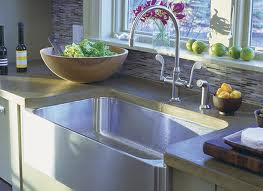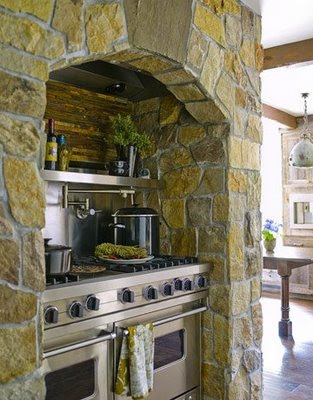Whether you are a design professional or an educated homeowner you’ve probably heard the term “kitchen work triangle”. In fact it’s probably one of the first things you learn when endeavoring to create a new kitchen. Who thought this up? It is actually the result of a study made at the University of Illinois in the 1950s! If you’re wondering if it could be outdated, just think of how much kitchens have changed since then in terms of products, appliances and how we use them.The National Kitchen and Bath Association (NKBA) defines the kitchen “work triangle” an imaginary straight line drawn from the center of the sink, to the center of the cook top, to the center of the refrigerator and finally back to the sink.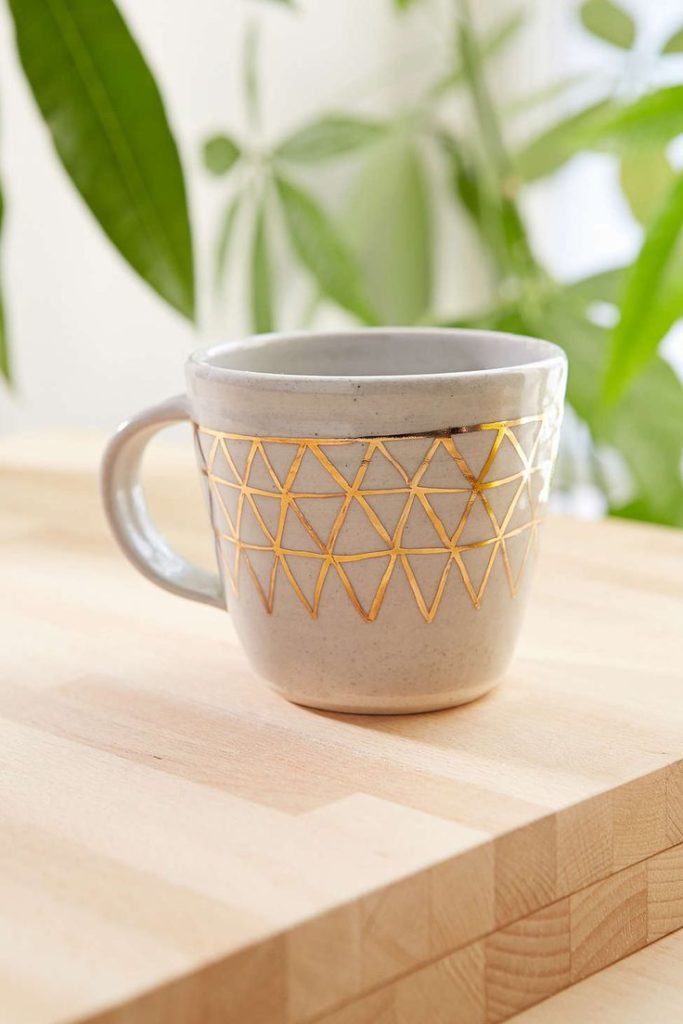 The NKBA suggests the following guidelines for determining a work triangle:- The sum of the work triangle's three sides should not exceed 26 ft. and each leg should measure between 4 ft. and 9 ft.
The NKBA suggests the following guidelines for determining a work triangle:- The sum of the work triangle's three sides should not exceed 26 ft. and each leg should measure between 4 ft. and 9 ft.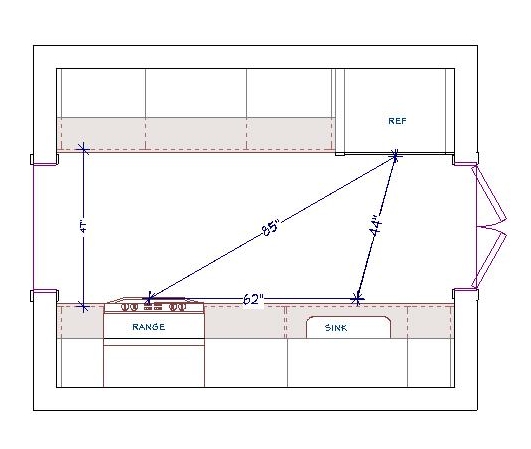 - The work triangle should not cut through an island or peninsula by more than 12 inches.- If the kitchen has only one sink, it should be placed between or across from the cooking surface, preparation area or refrigerator.Yes, this makes kitchen design sound a bit like solving a puzzle and, actually, it really is. I know my design is “right” when the layout works from every angle in terms of safety, ease of function and, of course, aesthetics.
- The work triangle should not cut through an island or peninsula by more than 12 inches.- If the kitchen has only one sink, it should be placed between or across from the cooking surface, preparation area or refrigerator.Yes, this makes kitchen design sound a bit like solving a puzzle and, actually, it really is. I know my design is “right” when the layout works from every angle in terms of safety, ease of function and, of course, aesthetics.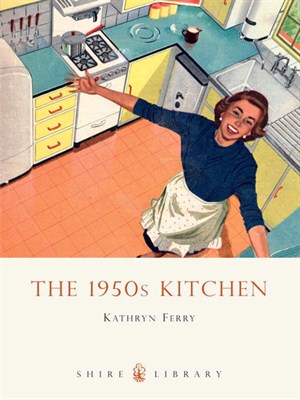 Some of the design solution is just good sound common sense but much of it should be directed by the individual needs of the client. I don’t “do” the triangle as a rule. Today we have multiple cook kitchens and no end of possible appliances. Modern kitchens are so unlike those of 60 years ago, so I use the more updated concept of “work centers”. The basic ones are food prep, cooking, clean up and storage.
Some of the design solution is just good sound common sense but much of it should be directed by the individual needs of the client. I don’t “do” the triangle as a rule. Today we have multiple cook kitchens and no end of possible appliances. Modern kitchens are so unlike those of 60 years ago, so I use the more updated concept of “work centers”. The basic ones are food prep, cooking, clean up and storage. 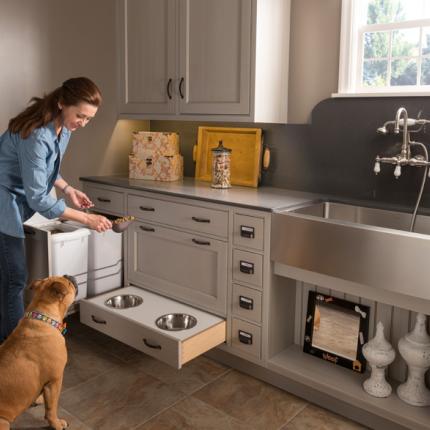 So while efficiency is still at the forefront, the thinking is a bit more evolved to address twenty first century needs.In a perfect world, work centers should be situated to allow someone to work in one area without getting in the way of someone using another. However, let’s face it, in a very small kitchen that is just not going to happen! The focus then is twofold: enough storage and enough counter space.
So while efficiency is still at the forefront, the thinking is a bit more evolved to address twenty first century needs.In a perfect world, work centers should be situated to allow someone to work in one area without getting in the way of someone using another. However, let’s face it, in a very small kitchen that is just not going to happen! The focus then is twofold: enough storage and enough counter space.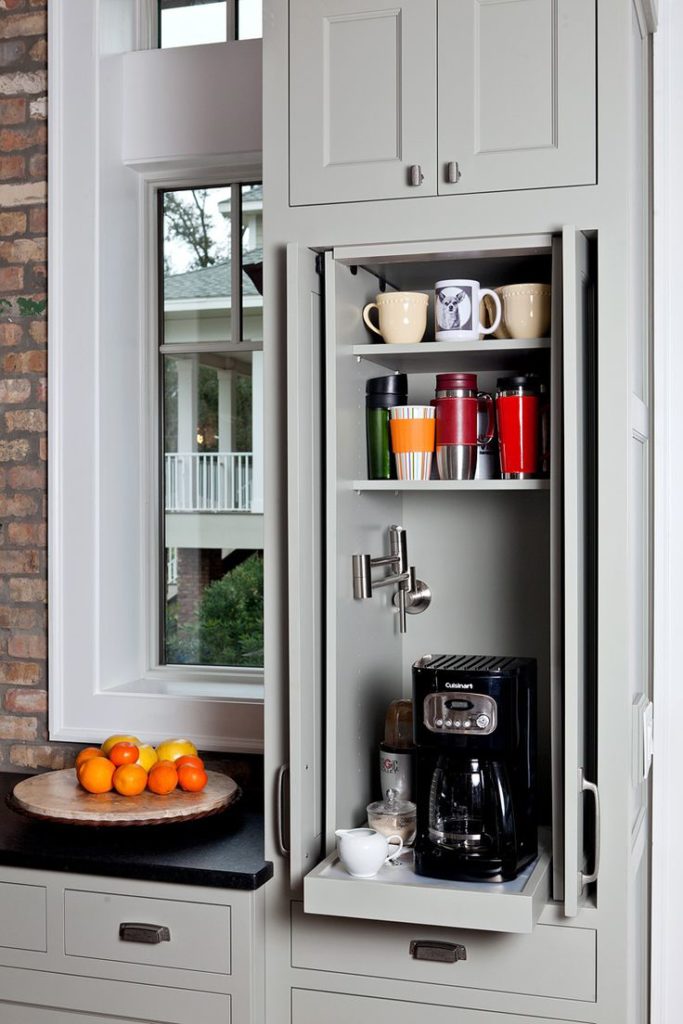 The types of work centers you can have is only limited by your imagination. Here are some good ones:-Beverage center- It can be coffee/tea, smoothies, wine or cocktails-Media center-It can be sit down area for menu planning, computer, charging station or TV-Baking center- You can trick this area out with customized storage for bake ware, bowls, utensils and a marble top for rolling dough.
The types of work centers you can have is only limited by your imagination. Here are some good ones:-Beverage center- It can be coffee/tea, smoothies, wine or cocktails-Media center-It can be sit down area for menu planning, computer, charging station or TV-Baking center- You can trick this area out with customized storage for bake ware, bowls, utensils and a marble top for rolling dough.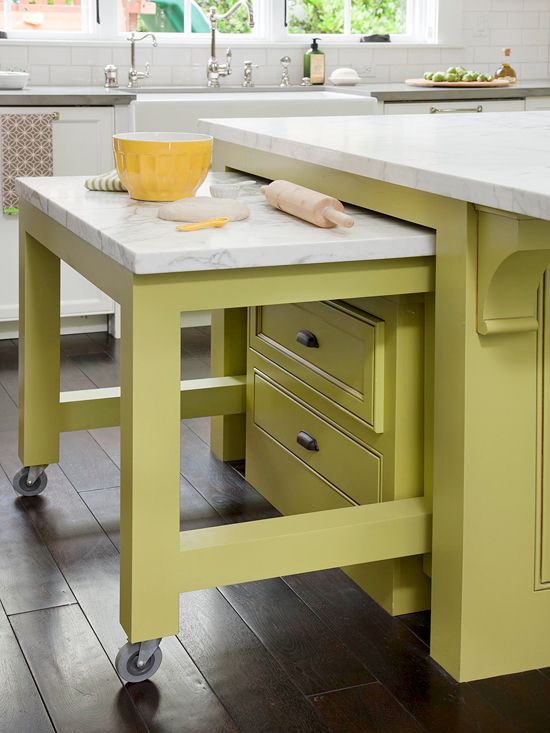 Remember that an “artful kitchen” employs what I call “practical creativity”. Function is the infrastructure, beauty comes next, the art is getting both just right.
Remember that an “artful kitchen” employs what I call “practical creativity”. Function is the infrastructure, beauty comes next, the art is getting both just right.
DESIGN AND THE MODERN KITCHEN
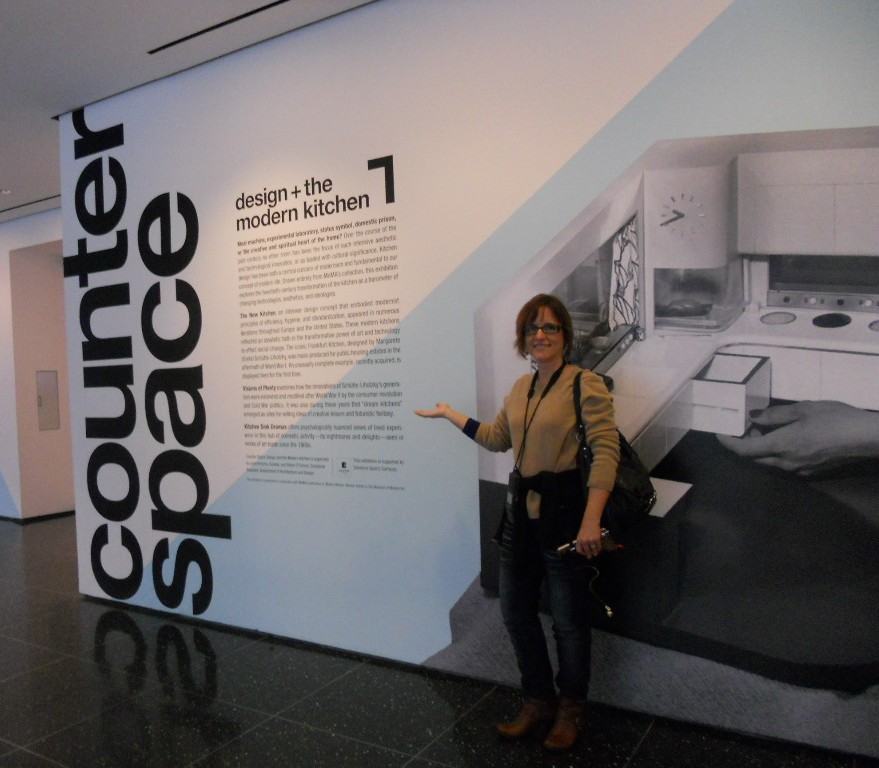 Granted I'm biased, but I have to say that Counter Space: Design and the Modern Kitchen is the most engaging exhibit I have had the pleasure of attending. It opened at the Museum of Modern Art September 15th and closes on March 11th. The thing about this show is that we can all identify and connect with the topic of kitchens. They are an integral part of how we live but we seldom give thought to exactly how they came about. You can find just about all there is to know right here.
Granted I'm biased, but I have to say that Counter Space: Design and the Modern Kitchen is the most engaging exhibit I have had the pleasure of attending. It opened at the Museum of Modern Art September 15th and closes on March 11th. The thing about this show is that we can all identify and connect with the topic of kitchens. They are an integral part of how we live but we seldom give thought to exactly how they came about. You can find just about all there is to know right here.
 The only critique I have is that I wish they would have included commentary post midcentury. The concepts of the kitchen are so dynamic and there is a lot to be said with regard to the last half of the 20th century. Nevertheless, especially for a kitchen professional or enthusiast this is an absorbing and engaging experience. The exhibit is divided into three main segments.
The only critique I have is that I wish they would have included commentary post midcentury. The concepts of the kitchen are so dynamic and there is a lot to be said with regard to the last half of the 20th century. Nevertheless, especially for a kitchen professional or enthusiast this is an absorbing and engaging experience. The exhibit is divided into three main segments.

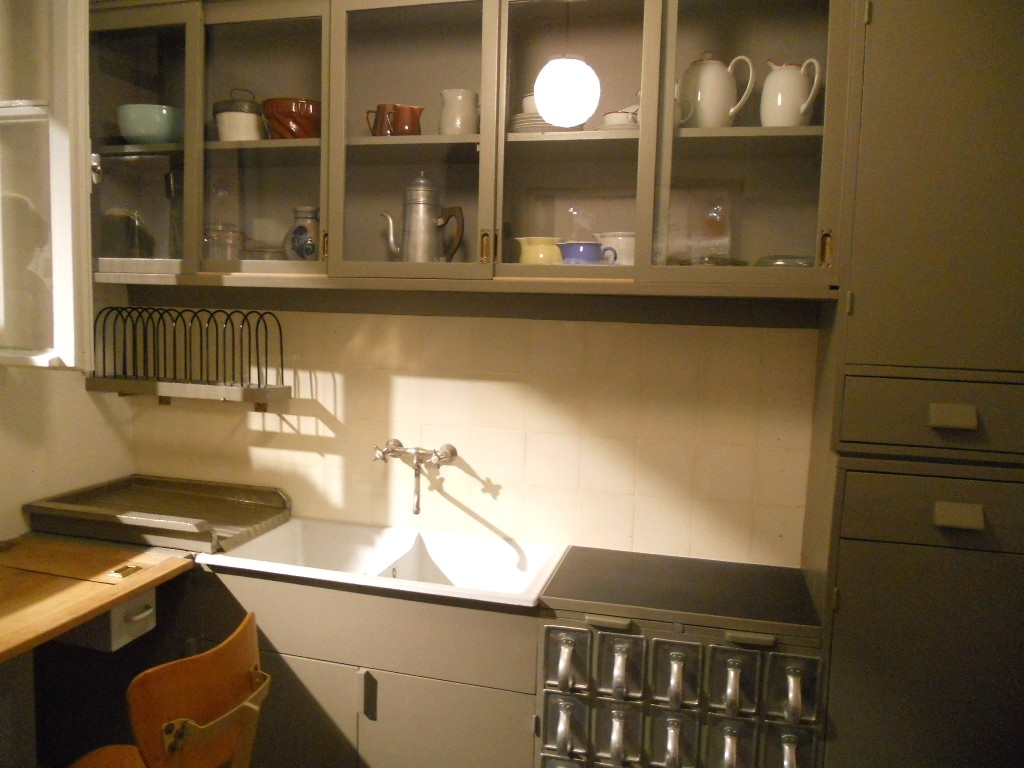 "Toward the Modern Kitchen" examines the early research in efficiency and time management that culminated in the design of the Frankfurt kitchen in 1928 by Margrete Schutte Lihosky. A post World War I housing crisis provided the impetus for such reasearch resulting in what is thought to be the first "modern" kitchen. You can read more about this history on a previous post here. It was believed that by transforming daily life at the level of he kitchen behavioral change and social well being would result. Good old German efficiency and practicality were at the heart of these inventions and it was two women in particular who made the biggest contributions, researcher Christine Frederick, as well as architect Margrete Schutte Lihosky.
"Toward the Modern Kitchen" examines the early research in efficiency and time management that culminated in the design of the Frankfurt kitchen in 1928 by Margrete Schutte Lihosky. A post World War I housing crisis provided the impetus for such reasearch resulting in what is thought to be the first "modern" kitchen. You can read more about this history on a previous post here. It was believed that by transforming daily life at the level of he kitchen behavioral change and social well being would result. Good old German efficiency and practicality were at the heart of these inventions and it was two women in particular who made the biggest contributions, researcher Christine Frederick, as well as architect Margrete Schutte Lihosky.
 The second part of the show is "Visions of Plenty" and deals with the post-war kitchens in America. It was then that the ergonomic considerations begun by Ms. Lihosky were further refined and a standard counter height of 36" was established. This was based on the average height of a woman at the time. Kitchens also began to evolve into living areas at this time and were very influenced by food restrictions brought about by the second world war.In addition myriad everyday objects are on display throughout the show. We never think about where the things we use everyday come from but they have a history and were shaped by our culture and time.
The second part of the show is "Visions of Plenty" and deals with the post-war kitchens in America. It was then that the ergonomic considerations begun by Ms. Lihosky were further refined and a standard counter height of 36" was established. This was based on the average height of a woman at the time. Kitchens also began to evolve into living areas at this time and were very influenced by food restrictions brought about by the second world war.In addition myriad everyday objects are on display throughout the show. We never think about where the things we use everyday come from but they have a history and were shaped by our culture and time.
 The final part of the exhibit is entitled "Kitchen Sink Dramas" which deals with kitchens as they are portrayed in the media as a rich subject for artistic expression.
The final part of the exhibit is entitled "Kitchen Sink Dramas" which deals with kitchens as they are portrayed in the media as a rich subject for artistic expression. If you would like to know more about this exhibit and rich history you can purchase a hard cover edition catalogue of Counter Space produced in conjunction with the exhibit and available by clicking here One final note that I have not seen mentioned is that this show was sponsored by Silestone Quartz Surfaces. I'm headed back home to the drawing board today with visions of tupperware and proto-type kitchens dancing in my head!
If you would like to know more about this exhibit and rich history you can purchase a hard cover edition catalogue of Counter Space produced in conjunction with the exhibit and available by clicking here One final note that I have not seen mentioned is that this show was sponsored by Silestone Quartz Surfaces. I'm headed back home to the drawing board today with visions of tupperware and proto-type kitchens dancing in my head!
LET THERE BE KITCHENS
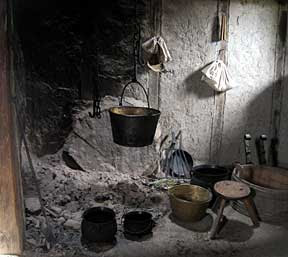 |
||
| It doesn't get much more basic than this! www.williamrubel.com |
As I explore and research the concept of the intuitive kitchen for my new book I find myself wanting to start from the very beginning. What were the first kitchens like and how did they evolve? The obvious answer is that they developed to better suit the needs and lifestyles of our ancestors. The first kitchens consisted of only one essential element which is fire. When that fire was located indoors the first kitchen was born. These fires were not only used to cook but to heat the home, or at least main living area. It was truly the warm heart of the home. As cultures advanced and segments of it became more affluent, kitchens were located away from the main living areas to keep smoke and cooking odors at bay and to keep the help out of sight! (I would have thought "help" would be a sight for sore eyes!) I remember touring a southern plantation which housed a free standing kitchen. The guide explained that the threat of fire also motivated building a separate structure for the kitchen. Should it burn down, hopefully, it would not take the main house with it.
 |
||
| The hand pump was used in the US even in the 1940s! |
The second essential element to come into the kitchen was, of course, water. At first manual pumps brought water indoors not to be followed by modern plumbing until the late19th century. Why is this important to my kitchen today, you ask? The reason is because this brings us back to the most basic essentials, your cooking appliances, sink and faucet.
This sink and faucet combo is by Kohler and the modern day hearth features a Viking range. These represent state-of-the-art "basics" and a good place to begin planning your kitchen. If state-of-the-art is not in your budget, no worries, today's competitive market offers many beautiful, quality products at more consumer friendly price points. Just make sure to do the research, especially when purchasing on line. Check warranty policies and never hesitate to contact a kitchen professional before you spend any amount of money. A simple consultation could be your best investment. Next post- The First Modern Kitchen

